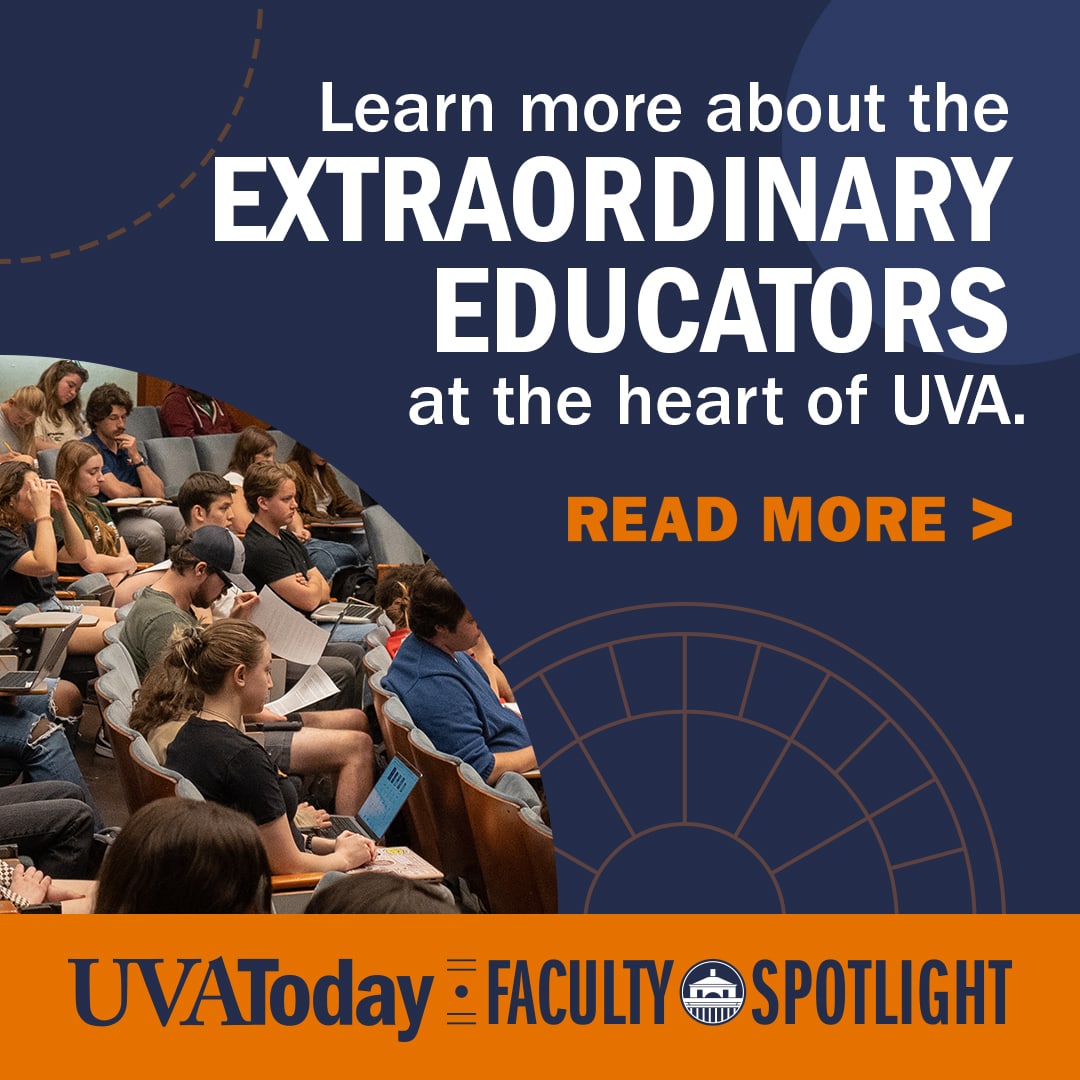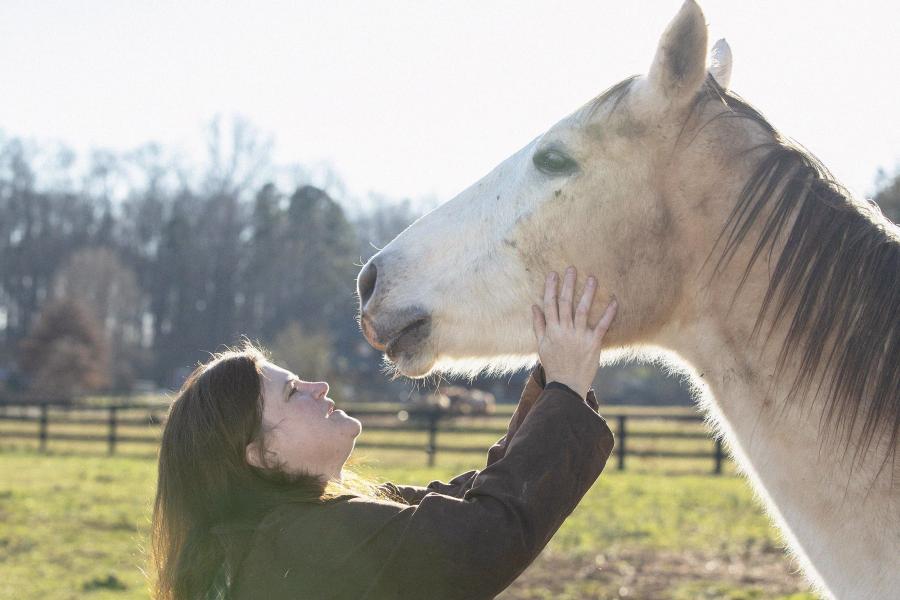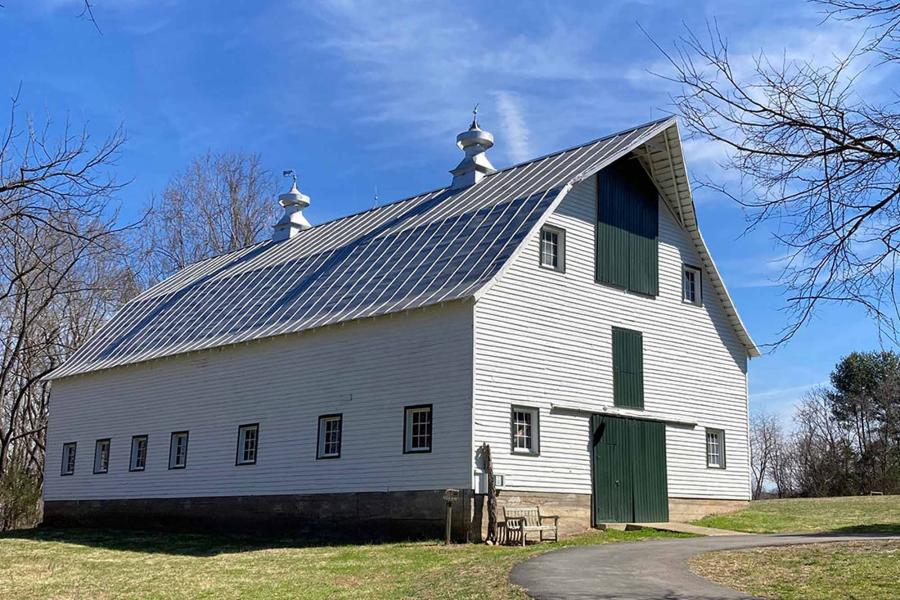The drive to Feel Better Farm Equine and Farm Animal Rescue is serene. Head straight down Route 20 South toward Scottsville, then turn right onto a snug road that crosses two charming, one-lane bridges.
As you near the farm’s 20 acres, the serenity is obliterated by the calls of more than 100 animals – geese, chickens, sheep, goats, pigs, horses and donkeys – and they are really loud. Above the cacophony rises the bray of an American Mammoth Jackstock mule.
“That’s Banjo,” said Sarah Osborn Barwick, a UVA Health software expert and owner of the farm. Banjo is the unofficial greeter at Feel Better Farm, which Barwick and her husband Jason started in 2016.

Sarah Osborn Barwick, a UVA Health software expert, with Blackberry the pony and Apple Carrot, a hinny – the offspring of a male horse and a female donkey. (Photo by Matt Riley, University Communications)
“We have 14 horses on (the) property and we also have another 11 in foster homes,” Barwick said, including Banjo and Timber, a donkey, in the horse count. “We have 11 sheep. We have 13 goats. We have 22 pigs, and some of these are here and some of them are in foster homes. We have 13 geese, six turkeys (and) 25 ducks. I don’t know how many chickens we have. We have four guineas.”
That’s a lot of mouths to feed. Barwick says the top expenses for the nonprofit, in order, are hay, feed and veterinary care. The farm always welcomes donations and volunteers.
“We go through about 300 pounds of bird food – cracked corn, sunflower seeds, pellets – a week. And that’s just for the fowl,” Barwick said. “Hay is predominant for everybody. All of the animals here, the mammals, rely on hay. That is the fundamental part of their diet … high, good quality forage.”
The farm uses round bales of hay in the field, “which are about 65 bucks a bale. And we have five fields going. One (bale) lasts about a week,” she added.
Feeding is where the community can lend a hand, especially this time of year, and it’s easy. Feel Better Farm wants your Halloween pumpkins.
Sarah Osborn Barwick: Pumpkin, you’re going to lose that, honey. Can I help you with that, ma’am?
I’m not one to get in the way of pig and his pumpkin, but ….
Matt Riley: This is Pumpkin eating a pumpkin?
Barwick: That is Pumpkin eating a pumpkin. Pumpkin and Pecan, his sister, came when they were little piglets this time last year from a seizure in Cumberland County.
“The pumpkins are a huge deal for us in the winter because, again, feed is incredibly expensive. And pumpkins are delicious when you’re a pig or a goat or even the horses and the turkeys and chickens,” the farm owner said.
Pumpkins are nutritious. And, in a good year, the farm can feed the animals pumpkins through the end of January.
Several Lawn residents at the University of Virginia are helping get pumpkins to Banjo, Timber and Spooky, a baby goat who uses wheels to get around because she was born without the use of her hind legs.
Sarah Osborn Barwick: You got an itch? Nope? Fixed? Go on, then. Off you go, trouble. Go ahead. Go.
“It’s really great when people have harmonizing needs, that they need to get rid of their pumpkins after Halloween and the animals need them for the winter,” said Allison McVey, a fourth-year student who chairs the University Judiciary Committee.
“There are so many around and we might as well put them to good use,” added Thomas Ackleson, another fourth-year student and chair of the Honor Committee.
The students have designated three drop-off points on Grounds from Nov. 19 to 21. They will be in the Newcomb Hall patio area; Patterson Alley, off the west side of the Lawn; and near Observatory Hill Dining Hall. Community members, students, faculty and staff are invited to participate in the pumpkin drive. The student leaders are also organizing a drop-off location in Charlottesville.










